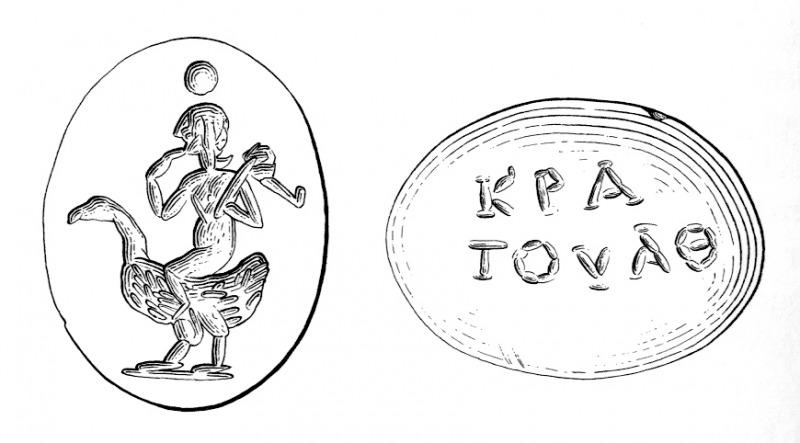Bonner, SMA, 144.
seated on the head of a scarab.21 Another design, which coincides with a coin type, represents Harpocrates seated on the back of a sphinx.22 In still another Harpocrates is riding a goose, a bird which, according to Erman,23 was connected with Amon-Re in the time of the New Kingdom, but is later given to Harpocrates.24 This design, which is used in other minor arts of Graeco-Roman Egypt, especially small terracottas and bronzes, is probably little more than an expression of a playful tendency to treat the young god as a mischievous child, as the Greeks represented Eros.25 The same tendency may be at work in types which represent Harpocrates riding a lion;26 but here solar symbolism is predominant. Thus on an onyx in the De Clercq collection Horus, with right hand extended, and holding the flail over his left shoulder, bestrides a lion.27 An inscription on the reverse contains several words usually associated with solar deities. It has been pointed out further that the zodiacal sign of Leo is known as the house of the sun.
There are still other designs which indicate the close approach of the young Harpocrates to the characteristics of Eros. He is given wings on some Alexandrian terracottas, and apparently also on a Berlin gem published by Pieper.28 The fusion with Eros probably explains why Harpocrates is the reverse type on a gem which has for its obverse design Aphrodite drying her hair; on another the symbolic group of a helmeted warrior leading a draped woman (Ares and Aphrodite) is seen in the field of a stone representing Harpocrates throned on the lotus.29 Another in the Michigan collection shows its connection with love magic only by the inscriptions; on the obverse, Harpocrates on the lotus with the adoring cynocephalus, on the reverse, the word αροριπασι (properly Αρωριφρασις), a magical name of Aphrodite, and on the bevel, the words ευτυκης αγαθοπος (εὐτυχὴς Ἀγάθωπος, perhaps with an ellipsis of ἔστω), a wish for good fortune to the wearer in a love affair.30
The numerous amulets in which Harpocrates appears merely as the divine infant are evidently tokens of the simple religion of the Egyptian family. From dynastic down to late Roman times the art of Egypt loved to depict the child Horus at the breast of his mother Isis or held on the knees of the goddess.31 A rock crystal amulet in the Michigan collection, which may go back to the Ptolemaic period, shows this design; but here the goddess is Isis-Hathor, with the head of a cow and wearing the crown of horns clasping the moon disk.32 The stones of later date are usually steatite or jasper (dark
21 B. M. 56134; King, Gnostics, Pl. C5.
22 Barry, Ann. du serv., 7, 246, Pl. 1, 4; D. 20; B. M. Cat. Alex., 460, Pl. 17; Dattari 893, 1726, 3464.
23 Erman, pp. 153, 392. The goose was also sacred to Isis.
25 See the discriminating and charmingly written paragraph in Perdrizet, Terres cuites, pp. 32–33.
26 Eros riding lions of Kybele, Luc. Dial. Deorum 12, 2.
27 De Ridder 3444, Pl. 28.
28 Perdrizet, Terres cuites, Nos. 99, 100, Pl. 27, below. Pieper, Mitt. des deutsch. Inst. in Kairo, 5, 140, 9769, Pl. 22b (not so clear as might be wished).
31 Budge, Gods, II, 208; B. M. Cat. Alex., Pl. 16, 762, 980, 1123; Dattari, Pl. 17, 1750, 2656, 4063.
Last modified: 2012-10-29 16:19:35
Link: cbd.mfab.hu/pandecta/1589








